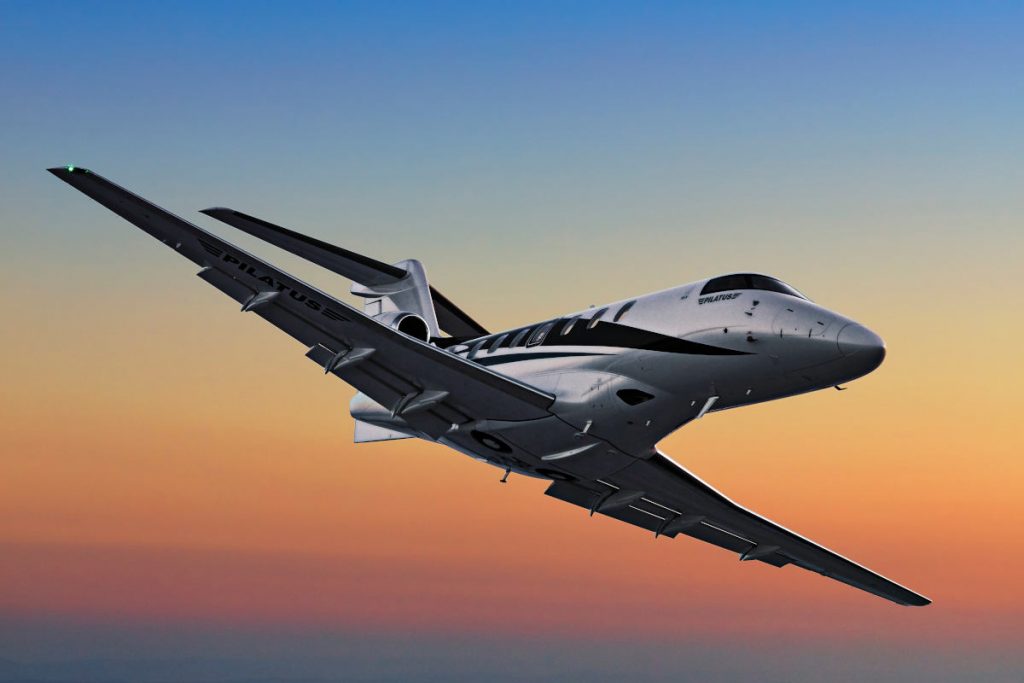
Features
Business Aviation
Jet revival, critical trends in business aviation
The state of business aviation around the world and in Canada
September 12, 2019 By Jon Robinson
 Oscar Schwenk led the creation of the first ever Swiss business jet, the Pilatus PC-24, which
received Transport Canada certification in June 2019. (Photo: Pilatus)
Oscar Schwenk led the creation of the first ever Swiss business jet, the Pilatus PC-24, which
received Transport Canada certification in June 2019. (Photo: Pilatus) After more than a decade of modest activity, triggered by the 2008 financial crisis, the global business aviation sector appears to be on the upswing based on statistics provided by Rolly Vincent, president of Rolland Vincent Associates LLC and director of JETNET iQ, during the mid-July Canadian Business Aviation Association (CBAA) conference in Calgary. The findings from JETNET iQ, a partnership established eight years ago between Vincent’s consultancy and aircraft-market-data firm JETNET LCC, hold typical forecasting caveats, today most notably seen as trade wars, long-term Brexit complications and struggling prime European economies.
JETNET iQ’s data, however, is largely supported by more than 17,000 survey responses from aircraft owners and operators in 132 countries over the past eight years, as well as statistical modelling designed for some of the industry’s most-influential aviation companies. Vincent spent close to an hour connecting the world’s predominant countries of business aviation with national economic output, preowned jet inventories, unprecedented availability of new airplane models, growing OEM backlogs, positive book-to-bill ratios, aircraft utilization, and the business outlook of operators.
Vincent explains the environment for new jet sales should become healthier over 2019 and 2020, in large part because of record growth in preowned aircraft transactions over the past two years, which has depleted available inventory. JETNET iQ data shows there are approximately 4 1/2 preowned airplanes sold for every new airplane.
“The number of retail transactions for preowned jets worldwide is down 20 per cent in the first five months of this year. We are watching it carefully because that is a very important indicator of some mood changes going on in the market,” says Vincent. “It reflects that the quality of the [preowned] inventory has been diminished – the shelves are empty.”
The business-jet inventory, as a percentage of the worldwide fleet, was 9.3 per cent as of March 31, 2019, according to JETNET iQ, which is the lowest such level in a decade, decreasing from 15.6 per cent in 2010. The turboprop inventory has also decreased from 11.2 per cent in 2010 to 6.7 per cent in mid-2019. Turboprops account for close to 60 per cent of Canada’s total business aviation fleet of 1,345 aircraft. Vincent explains this positions Canada as number two in the world in turboprops and number four in business jets behind the U.S., Brazil and Mexico.
North American inventory
To put the business-aviation dominance of the U.S. into perspective, the country holds approximately 22,000 aircraft in its total fleet, with just under 14,000 business jets. This presents a potentially critical disruption to any aircraft-market forecasts, particularly in terms of inventory and new jet sales, as the U.S. approaches the FAA-mandated January 1, 2020, deadline for installing Automatic Dependent Surveillance-Broadcast (ADS-B) systems. Simply put, if an aircraft is not ADS-B Out compliant, it will not fly in U.S. airspace.
“This is going to put a lot of airplanes not only on the ground but also in the boneyard,” says Vincent, noting there are some low-cost solutions for ADS-B Out, but the costs of avionics upgrades and the limits of MRO capacity, cannot be ignored. “We think several thousand business jets are not going to make the deadline. It is bigger than the size of the Canadian fleet by maybe four or five orders of magnitude.” This environment can improve the availability of inventory for Canadian operators, but of course such investments are not likely without the ability to fly in American airspace and Canada faces its own ADS-B Out deadline tentatively scheduled for the 2021 timeframe.
ADS-B was one of three critical issues to come out JETNET iQ’s most recent second-quarter survey, which was completed just days before the CBAA conference. Owners and operators were asked if their aircraft will be ADS-B Out compliant by December 31, 2019: 63 per cent of the 50 Canadian operators who responded to the survey strongly agreed with this statement, but 22.2 per cent strongly disagreed.
The second critical issue asked if recruiting and retaining pilots or technicians was difficult, to which 72 per cent of global operators either strongly or somewhat agreed with and – even more alarming – 90.3 per cent of Canadian operators responded the same way. The third critical issue asked if there is an increasing risk of a global economic slowdown in the next 12 months, to which approximately 57 per cent of global respondents either strongly or somewhat agreed (60 per cent in Canada). This is reflected in a recent decline of what JETNET iQ defines as net optimism for the current conditions of business aviation, an equation of three variables: whether the market has not yet reached the low point, is at the low point, or past the low point.
The net optimism of all survey respondents was 23.3 per cent in the 2019 second-quarter survey, which Vincent describes as still relatively healthy; noting this decline is earmarked by a historic 10-year high in the second quarter of 2018 when it reached 55.1 per cent. For comparison, net optimism in the 2016 third quarter was 6.6 per cent. Canadian respondents in JETNET iQ’s 2019 second quarter survey held a net optimism of 20 per cent, as 50 per cent described business aviation as being past the low point and ready for growth.
JETNET iQ’s 2019 second-quarter survey also asked Canadian operators what one new aircraft model they are most interested in purchasing. The Pilatus PC-24 came out on top in the survey, more than double any other aircraft model. “This is an airplane that is getting a lot of attention. Pilatus has done some really interesting things,” says Vincent.

New business jet competition
The PC-24 jet received Transport Canada certification in June 2019 and two days later the first such aircraft was delivered to a Canadian operator, just before the CBAA conference in Calgary where the PC-24 made its national static-display debut. “We were very busy during the show. From a half of an hour before the show began until a half of an hour after it closed, there were people lining up to get into the airplane,” says Stan Kuliavas, VP of sales and business development at Levaero Aviation, the exclusive Pilatus distributer in Canada. “People were really impressed with how big and roomy the cabin is and what a huge difference the flat floor makes.”
Kuliavas continues to explain the flat floor feature of the PC-24 is typically found in aircraft that are almost double the price. With a list price of US$10.7 million, the pressurized PC-24 is the first jet developed by Pilatus, best known for its workhorse PC-12 and PC-6 turboprops. It holds 501 cubic feet of cabin space and 90 cubic feet of storage space accessible both internally and through an industry-unique cargo door now leveraged by both the PC-12 and PC-24. Branded by Pilatus as the only Super Versatile Jet in the world, with operators having access to almost twice as many airports worldwide when compared to other jets on the market, the PC-24 – akin to the Swiss aircraft maker’s PC-12 – maintains the ability to safely land on unpaved surfaces with distinct short-field performance for its class.
More than 40 PC-24 aircraft have already been delivered, collectively amassing more than 7,000 flight hours since EASA and FAA certification in late-2017. Kuliavas explains, that much like the PC-12’s operating cost of approximately $615 per hour with six to eight passengers, the PC-24 also holds huge potential as a cost-effective business tool operating in the range of $1,250 to $1,300 per hour.
“To move a cabin like this around at that direct operating cost, you are not seeing that in any other airplane,” he says, also pointing to the historic strength of Pilatus aircraft residual values. “Pilatus does not discount its products. There is inherent value in what you are buying. Second, they do not overproduce aircraft and dump them into the market and, third, the resale market for these airplanes is diverse.”
These factors helped drive Pilatus’ turboprop success with the hundredth PC-12 registered in Canada back in August 2018. “The PC-24 builds on the success of the PC-12. It has longer range. It is faster. It can carry more load, but it doesn’t lose the short field capability or the single-pilot aspect.”
Vincent explains that considering the residual value of an aircraft is more important than ever, largely because there are now more than 40 new business jet models available. He emphasizes this market imbalance by the fact that only 650 new aircraft were delivered last year, including a few star models with more than 50 total deliveries – as most healthy models are delivering on average at around 12 airplanes per year. “We think the industry is offering too much to the market given the demand and we see a correction coming… If you have some models in your fleets that are not in a highly produced form, you might want to consider the impact of the residual value when that production decision occurs.”
As the PC-24 was achieving Transport Canada certification, Gulfstream in June 2019 also earned FAA Type and Production Certifications for its G600, in addition to the July-2018 approval of the G500. Bombardier launched its new flagship Global 7500 aircraft in December 2018.
Vincent notes, that among the five big OEMs in business aviation, Bombardier and Gulfstream are the two companies well positioned in terms of backlog (orders based on contracts signed), which has increased significantly over the past year. “After 11 years, finally we see backlogs increasing. They have been dropping at double-digit percentage rates for the last few years,” he says, describing this position as another healthy sign of future growth for business aviation. “Our numbers are going to show around five per cent increase in deliveries from the factories worldwide this year, in units, and probably around the same again the following year.”
JETNET iQ data also shows a steep increase in book-to-bill, the ratio of orders coming in relative to deliveries going out, over the past few quarters, which Vincent expects to settle into another positive position for business aviation growth. “Over the full year we are expecting book-to-bill to be above one and this is very nice, as you have seen where we have been in this industry since the financial crisis.”